If you know of a query tool that generates SQL statements, you may consider using that tool to facilitate the writing of queries used in OpenRPT report definitions. Having an external query builder can help to accelerate the creation of report definitions. In this section we will look at an example of how this process works using one such query builder: Microsoft Query, which is a component of the Excel program.
Note
Using external query tools can be helpful, as OpenRPT does not currently have a native query builder.
Microsoft defines the query builder embedded within its Excel application as follows: “Microsoft Query is a program for bringing data from external sources into other Microsoft Office programs— in particular, Microsoft Excel. By using Query to retrieve data from your corporate databases.”
Remember, we are most interested in MS Query as a means for generating SQL statements which we can then run against our xTuple Database. Again, having predefined queries will help accelerate the report building process in OpenRPT.
In this section we will illustrate how to use Excel’s MS Query to build a query which we will then insert into an OpenRPT report definition to generate a report. Below is the final SQL generated by MS Query using our ODBC connection to the usr table in our xTuple Database:
SELECT usr.usr_id, usr.usr_username, usr.usr_propername, usr.usr_passwd,
usr.usr_locale_id, usr.usr_initials, usr.usr_agent, usr.usr_active,
usr.usr_email
FROM public.usr usr
ORDER BY usr.usr_usernameNow we will show the steps involved to generate the predefined query.
First, open the Excel application. From the “Data” menu select the “Get External Data” option. Then select the “New Database Query” option. You will be presented with the following screen:

Select the new ODBC connection you just created against your PostgreSQL database, and then click the OK button.
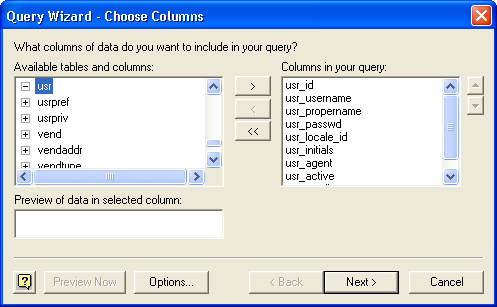
In the left column, scroll to the table usr and click on it. Then select the “>” button to select all columns in the table. Finally, select the NEXT button to be brought to the following screen:
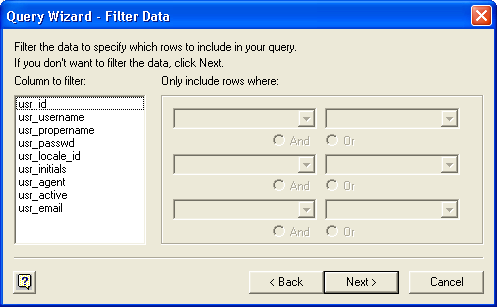
Next, the Query Wizard provides you with the opportunity to filter the data. For this exercise, we will choose not apply a filter to the data. Click the NEXT button to reach the following screen:
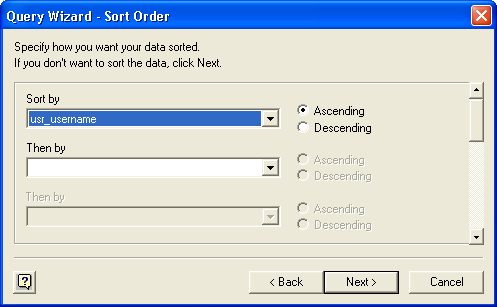
We will define one sort criteria. In the “Sort by” field select the column usr_username and check “Ascending” next to it. Click the NEXT button to reach the next screen:

Because we are only using Query to generate an SQL statement, we check the option “View data or edit query in Microsoft Query.” Click the FINISH button.
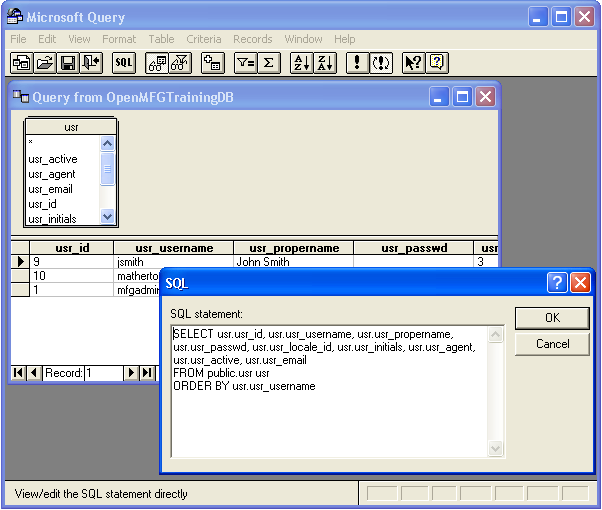
Initially, Query displays the results of the query we just created with the Query Wizard. To see the syntax of the SQL statement, click the SQL tool in the toolbar.
To copy this SQL statement for importing into an OpenRPT report definition, select the statement and then right click and use the “Copy” option. Later you can paste the statement into an OpenRPT Query Source.
Earlier chapters in this user guide covered the details of modifying and creating OpenRPT report definitions. The next few screens show the core elements of a report definition and the resulting output.
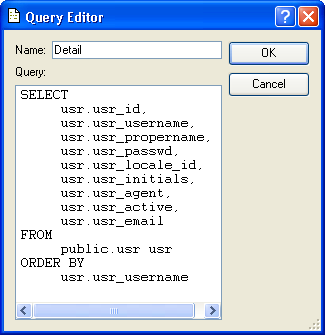
Above you can see the SQL statement exactly as it was copied from Microsoft Query and pasted into an OpenRPT Query Source for a new report definition. We will run this report using the xTuple application—and so we will save it with the already-existing report definition name “UsersMasterList.” To distinguish this version of the report from others, we will assign this version a Grade of “20.” In xTuple, report definitions having the highest grade are used. Assuming “20” is the highest grade for “UsersMasterList,” our new version will be run with users select PRINT from the xTuple master list of users.
Note
The SQL in our example is the exact same SQL statement as it was copied from Microsoft Query. MetaSQL has not been added to it. When printing the user master list from xTuple, the client passes the parameters locale_id and showInactive to the report definition at run time. These parameter values can be used to create sophisticated WHERE clauses that show data on the report based on user entries on the User screen. Remember, you can use the MetaSQL Editor to test SQL that contains MetaSQL before pasting into a report’s Query Source. MetaSQL is covered in another chapter of this user guide.
Below is a look at the report definition we created using the query we built with Microsoft Query.
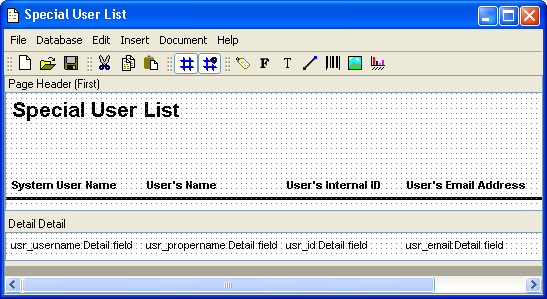
This report definition will be run when an xTuple user selects PRINT on the following xTuple screen:
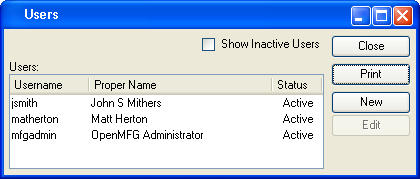
After we select PRINT, the report definition is printed just as we planned:
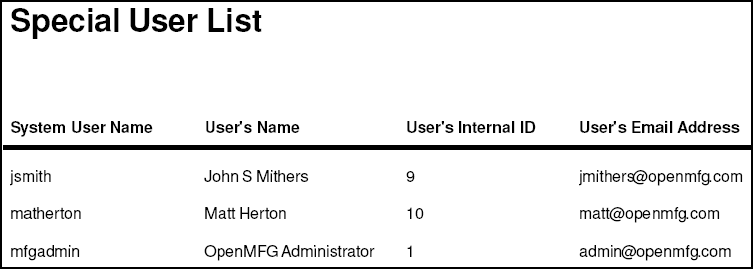
The report shown above was generated using the SQL we copied from Microsoft Query. It demonstrates the speed and ease with which new reports can be created and deployed using OpenRPT.